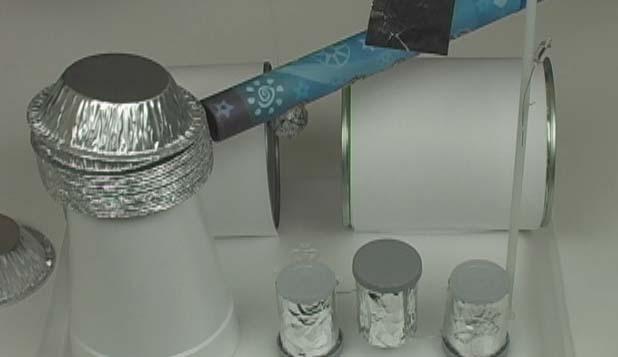If you have a Fun Fly Stick, then pull it out and watch the video below. If not, don’t worry – you can do most of these experiments with a charged balloon (one that you’ve rubbed on your hair). Let’ play with a more static electricity experiments, including making things move, roll, spin, chime, light up, wiggle and more using static electricity!
[am4show have=’p8;p9;p97;p58;’ guest_error=’Guest error message’ user_error=’User error message’ ]
Materials:
- sheet of paper
- two empty, clean soup cans
- aluminum foil
- long straight pin
- three film canisters (or M&M containers)
- penny
- sheet of paper
- neon bulb
- small styrofoam ball
- fishing line or thread
- chopstick
- foam cup
- dozen small aluminum pie tins
- hot glue with glue sticks
- Fun Fly Stick (also called “Wonder Fly Stick”)
This video show you how to get the most out of your Fun Fly Stick. If you don’t have a Fly Stick, simply use an inflated balloon that you’ve rubbed on your head. In the video, the Electrostatic Lab is mounted on a foam meat tray I found at the grocery store.
Download Student Worksheet & Exercises
The triboelectric series is a list that ranks different materials according to how they lose or gain electrons. Near the top of the list are materials that take on a positive charge, such as air, human skin, glass, rabbit fur, human hair, wool, silk, and aluminum. Near the bottom of the list are materials that take on a negative charge, such as amber, rubber balloons, copper, brass, gold, cellophane tape, Teflon, and silicone rubber.
When you turn on your Fun Fly Stick (or rub your head with a balloon), one end of the Fun Fly Stick takes on a positive charge and the other end holds the negative charge. When you rub your head with a balloon, the hair takes on a positive charge and the balloon takes on a negative charge.
When you scuff along the carpet, you build up a static charge (of electrons). Your socks insulate you from the ground, and the electrons can’t cross your sock-barrier and zip back into the ground. When you touch someone (or something grounded, like a metal faucet), the electrons jump from you and complete the circuit, sending the electrons from you to them (or it).
Exercises
- What is common throughout all these experiments that make them work?
- What makes the neon bulb light up? What else would work besides a neon bulb?
- Does it matter how far apart the soup cans are?
- Why does the foil ball go back and forth between the two cans?
- Why do the pans take on the same charge as the Fly Stick?
- When sticking a sheet of paper to the wall, does it matter how long you charge the paper for?
- Draw a diagram to explain how the electrostatic motor works. Label each part and show where the charges are and how they make the rotor turn.
[/am4show]


You can get one here. It’s a small Van de Graff generator (a static electricity machine). Watch the video and you’ll see the fun things you can do with it!
Where do I get the Fly Stick? I’ve never herd of it.What does it do???